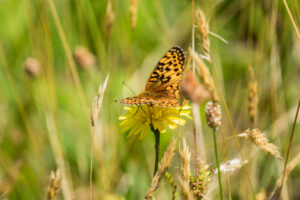
Conservationists transport Oregon silverspot caterpillars to slopes of the coast range
PORTLAND, Ore. — With forecasts calling for another hot week ahead, hundreds of the Oregon Zoo’s tiniest residents are heading for the coast.
Over the warmest days of summer, zoo butterfly specialists and their conservation partners have been releasing Oregon silverspots at select sites in the coastal mountain range in an effort to save this beautiful Northwest species.
To see video, visit bit.ly/SilverspotRecovery.
Once common in coastal grasslands from Northern California up into British Columbia, the Oregon silverspot has been listed as threatened under the federal Endangered Species Act since 1980. Today, just four isolated populations remain.
“Three of the last four silverspot populations would most likely be extinct if it weren’t for this recovery program,” said Travis Koons, who oversees the Oregon Zoo’s silverspot conservation efforts in partnership with the Oregon Parks and Recreation Department, the U.S. Fish and Wildlife Service and Seattle’s Woodland Park Zoo.
Each summer, a small number of female silverspots are collected by field biologists and brought to the zoo to lay eggs. The eggs hatch into tiny caterpillars, which are kept safe during their winter dormancy. In the spring, they wake up to a leafy meal and grow quickly.
When the weather grows warmer, the zoo and its conservation partners transport the silverspots — either as caterpillars or pupae — to field sites in order to bolster the three remaining Oregon populations.
“These beautiful pollinators have lost a lot of ground,” Koons said. “But if they continue to breed, and if we continue to restore and protect their habitat, we can give them a good chance to survive.”
In 2019, the Oregon Zoo became the first facility to successfully breed silverspots, and Koons said a small number of pupae will stay behind this year to complete their transformation into adult butterflies at the zoo — a “rear guard” of sorts that will breed and lay eggs to produce caterpillars for next year’s release.
Conservationists have also been working to establish a new population at Saddle Mountain, where the Oregon silverspot has not been seen since 1972. The area was added as a reintroduction site in 2018 because a rare flower — the early blue violet — blooms in abundance there.
Early blue violets are the main food source for the silverspot caterpillars as they mature into adult butterflies, and the Oregon coastal range is one of the few remaining areas where these flowers grow in large enough quantities to sustain a butterfly population. Elsewhere, the delicate flowers have been choked out by invasive weeds and forest succession.
As part of the Metro family, the Oregon Zoo helps make greater Portland a great place to call home. Committed to conservation, the zoo is also working to save endangered California condors, western pond turtles, Taylor’s checkerspot butterflies and northern leopard frogs. To learn more, visit oregonzoo.org/recovery.
Support from the Oregon Zoo Foundation enhances and expands the zoo’s efforts in conservation, education and animal welfare. Members, donors and corporate and foundation partners help the zoo make a difference across the region and around the world. To contribute, go to oregonzoo.org/donate.
The zoo is open from 9 a.m. to 6 p.m. Sunday through Thursday, and 9 a.m. to 8 p.m. on Friday and Saturday. To plan your trip, go to oregonzoo.org/visit. For more information on getting to the zoo, visit Explore Washington Park.
No Comments
Leave a comment Cancel